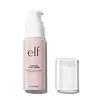What's inside
What's inside
 Key Ingredients
Key Ingredients

 Benefits
Benefits

 Concerns
Concerns

 Ingredients Side-by-side
Ingredients Side-by-side

Water
Skin ConditioningCyclopentasiloxane
EmollientTrimethylsiloxysilicate
EmollientAlcohol Denat.
AntimicrobialMethyl Methacrylate Crosspolymer
PEG-10 Dimethicone
Skin ConditioningSynthetic Fluorphlogopite
Butylene Glycol
HumectantCaprylyl Methicone
Skin ConditioningCetyl Ethylhexanoate
EmollientPentylene Glycol
Skin ConditioningTriethylhexanoin
MaskingDisteardimonium Hectorite
StabilisingGlycerin
HumectantAluminum Starch Octenylsuccinate
AbsorbentDiphenylsiloxy Phenyl Trimethicone
Skin ConditioningLauryl PEG-8 Dimethicone
Silica
AbrasiveMagnesium Sulfate
Tribehenin
EmollientPhenoxyethanol
PreservativeVinyldimethicone
PEG-Crosspolymer
CI 77891
Cosmetic ColorantTriethoxycaprylylsilane
Ethylhexylglycerin
Skin ConditioningParfum
MaskingAluminum Hydroxide
EmollientStearic Acid
CleansingDisodium EDTA
Ethylhexyl Palmitate
EmollientSodium PCA
HumectantMagnesium PCA
HumectantZinc PCA
HumectantSilica Dimethyl Silylate
EmollientCaprylyl Glycol
EmollientManganese PCA
HumectantPotassium Sorbate
PreservativeSodium Hyaluronate
HumectantHexylene Glycol
EmulsifyingGossypium Herbaceum Seed Extract
Skin ConditioningWater, Cyclopentasiloxane, Trimethylsiloxysilicate, Alcohol Denat., Methyl Methacrylate Crosspolymer, PEG-10 Dimethicone, Synthetic Fluorphlogopite, Butylene Glycol, Caprylyl Methicone, Cetyl Ethylhexanoate, Pentylene Glycol, Triethylhexanoin, Disteardimonium Hectorite, Glycerin, Aluminum Starch Octenylsuccinate, Diphenylsiloxy Phenyl Trimethicone, Lauryl PEG-8 Dimethicone, Silica, Magnesium Sulfate, Tribehenin, Phenoxyethanol, Vinyldimethicone, PEG-Crosspolymer, CI 77891, Triethoxycaprylylsilane, Ethylhexylglycerin, Parfum, Aluminum Hydroxide, Stearic Acid, Disodium EDTA, Ethylhexyl Palmitate, Sodium PCA, Magnesium PCA, Zinc PCA, Silica Dimethyl Silylate, Caprylyl Glycol, Manganese PCA, Potassium Sorbate, Sodium Hyaluronate, Hexylene Glycol, Gossypium Herbaceum Seed Extract
 Reviews
Reviews

Ingredients Explained
These ingredients are found in both products.
Ingredients higher up in an ingredient list are typically present in a larger amount.
Caprylyl Glycol is a humectant and emollient, meaning it attracts and preserves moisture.
It is a common ingredient in many products, especially those designed to hydrate skin. The primary benefits are retaining moisture, skin softening, and promoting a healthy skin barrier.
Though Caprylyl Glycol is an alcohol derived from fatty acids, it is not the kind that can dry out skin.
This ingredient is also used as a preservative to extend the life of products. It has slight antimicrobial properties.
Learn more about Caprylyl GlycolCi 77891 is a white pigment from Titanium dioxide. It is naturally found in minerals such as rutile and ilmenite.
It's main function is to add a white color to cosmetics. It can also be mixed with other colors to create different shades.
Ci 77891 is commonly found in sunscreens due to its ability to block UV rays.
Learn more about CI 77891Phenoxyethanol is a preservative that has germicide, antimicrobial, and aromatic properties. Studies show that phenoxyethanol can prevent microbial growth. By itself, it has a scent that is similar to that of a rose.
It's often used in formulations along with Caprylyl Glycol to preserve the shelf life of products.
Silica, also known as silicon dioxide, is a naturally occurring mineral. It is used as a fine, spherical, and porous powder in cosmetics.
Though it has exfoliant properties, the function of silica varies depending on the product.
The unique structure of silica enhances the spreadability and adds smoothness, making it a great texture enhancer.
It is also used as an active carrier, emulsifier, and mattifier due to its ability to absorb excess oil.
In some products, tiny microneedles called spicules are made from silica or hydrolyzed sponge. When you rub them in, they lightly polish away dead skin layers and enhance the penetration of active ingredients.
Learn more about Silica